Eukaryote Study guides, Class notes & Summaries
Looking for the best study guides, study notes and summaries about Eukaryote? On this page you'll find 1143 study documents about Eukaryote.
All 1.143 results
Sort by
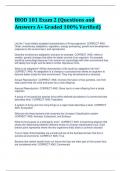 Popular
Popular
-
BIOD 101 Exam 2 (Questions and Answers A+ Graded 100% Verified)
- Exam (elaborations) • 2 pages • 2023
- Available in package deal
-
- $7.99
- 4x sold
- + learn more
BIOD 101 Exam 2 (Questions and Answers A+ Graded 100% Verified) List the 7 most widely accepted characteristics of living organisms CORRECT ANS: Order, evolutionary adaptation, regulation, energy processing, growth and development, response to the environment, and reproduction Describe evolutionary adaptation and give an example CORRECT ANS: refers to smaller, genetic changes that allow for better survival of an organism. An example would be camouflage because if an animal can camo...
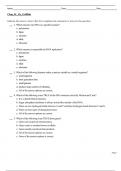 Popular
Popular
-
Test Bank for Introduction to Genetic Analysis, 12th Edition by Anthony Griffiths
- Exam (elaborations) • 406 pages • 2023 Popular
-
- $39.49
- 3x sold
- + learn more
Test Bank for Introduction to Genetic Analysis 12e 12th Edition by Anthony Griffiths, John Doebley; Catherine Peichel; David A. Wassarman. Full Chapters test bank are included - Chapter 1 to 20 1 The Genetics Revolution in the Life Sciences 2 Single-Gene Inheritance 3 Independent Assortment of Genes 4 Mapping Eukaryote Chromosomes by Recombination 5 Gene Interaction 6 The Genetics of Bacteria and Their Viruses 7 DNA: Structure and Replication 8 RNA: Transcription and Pr...
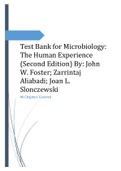
-
Test Bank for Microbiology: The Human Experience (Second Edition) By: John W. Foster; Zarrintaj Aliabadi; Joan L. Slonczewski All Chapters Covered
- Exam (elaborations) • 425 pages • 2023
-
- $15.49
- 4x sold
- + learn more
Test Bank for Microbiology: The Human Experience (Second Edition) By: John W. Foster; Zarrintaj Aliabadi; Joan L. Slonczewski All Chapters Covered Chapter 01: Microbes Shape Our History MULTIPLE CHOICE 1. Which of the following is NOT considered a benefit of microorganisms? a. nitrogen fixation c. synthesis of vitamins b. production of fermented foods d. causative agents of disease ANS: D DIF: Easy REF: 1.1 OBJ: 1.1a Describe how we define a microbe, and explain why the definition i...

-
OpenStax Microbiology Test Bank Chapter 5: The Eukaryotes of Microbiology
- Exam (elaborations) • 15 pages • 2023
- Available in package deal
-
- $8.99
- + learn more
OpenStax Microbiology Test Bank Chapter 5: The Eukaryotes of Microbiology/OpenStax Microbiology Test Bank Chapter 5: The Eukaryotes of Microbiology
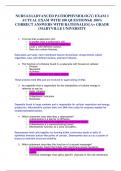
-
2023/2024 NURS 611(ADVANCED PATHOPHYSIOLOGY) EXAM 1 ACTUAL EXAM WITH 100 QUESTIONS& 100% CORRECT ANSWERS WITH RATIONALES| A+ GRADE (MARYVILLE UNIVERSITY
- Exam (elaborations) • 14 pages • 2023
- Available in package deal
-
- $15.99
- 1x sold
- + learn more
2023/2024 NURS 611(ADVANCED PATHOPHYSIOLOGY) EXAM 1 ACTUAL EXAM WITH 100 QUESTIONS& 100% CORRECT ANSWERS WITH RATIONALES| A+ GRADE (MARYVILLE UNIVERSITY 1. It is true that a eukaryotic cell: ○ Is smaller than a prokaryotic cell. ○ Contains structures called organelles. ○ Lacks a well-defined nucleus. ○ Does not contain histones. Eukaryotes are large, have membrane-bound intracellular compartments called organelles, has a well defined nucleus, and have histones. 2. The func...
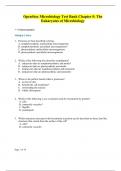
-
OpenStax Microbiology Test Bank Chapter 5: The Eukaryotes of Microbiology
- Exam (elaborations) • 14 pages • 2024
- Available in package deal
-
- $20.00
- + learn more
OpenStax Microbiology Test Bank Chapter 5: The Eukaryotes of Microbiology * = Correct answer Multiple Choice 1. Protozoa are best described as being: A. nonphotosynthetic multicellular microorganisms B. nonphotosynthetic unicellular microorganisms* C. photosynthetic multicellular microorganisms D. photosynthetic unicellular microorganisms 2. Which of the following best describes zooplankton? A. eukaryotes that are nonphotosynthetic and motile* B. eukaryotes that are photosynthet...
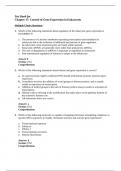
-
Chapter 17 Control of Gene Expression in Eukaryotes
- Exam (elaborations) • 18 pages • 2023
- Available in package deal
-
- $8.49
- + learn more
Chapter 17 Control of Gene Expression in Eukaryotes
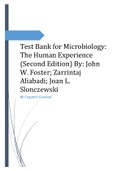
-
Test Bank for Microbiology: The Human Experience (Second Edition) By: John W. Foster; Zarrintaj Aliabadi; Joan L. Slonczewski All Chapters Covered
- Exam (elaborations) • 425 pages • 2023
-
- $15.49
- 1x sold
- + learn more
Test Bank for Microbiology: The Human Experience (Second Edition) By: John W. Foster; Zarrintaj Aliabadi; Joan L. Slonczewski All Chapters Covered Chapter 01: Microbes Shape Our History MULTIPLE CHOICE 1. Which of the following is NOT considered a benefit of microorganisms? a. nitrogen fixation c. synthesis of vitamins b. production of fermented foods d. causative agents of disease ANS: D DIF: Easy REF: 1.1 OBJ: 1.1a Describe how we define a microbe, and explain why the definition i...

-
MMSC 490 Final (Already Graded A+)
- Exam (elaborations) • 22 pages • 2023
- Available in package deal
-
- $13.99
- 1x sold
- + learn more
Which energy-producing process is thought to have come first during cellular evolution? correct answers Glycolysis The initial importance of a membrane enclosing self-replicating RNA molecules and associated proteins was that it correct answers maintained these molecules as a unit capable of reproduction and evolution. Mitochondria and chloroplasts resemble bacteria in that they correct answers have their own DNA, have their own ribosomes, reproduce by simple division into two. Which of...

-
UNIT 4 REVIEW BIO 1510 QUESTION AND ANSWERS (VERIFIED ANSWERS) In eukaryotes, the idea that one gene codes for one protein has been modified because - ANSWER one gene can code for multiple proteins via alternative splicing. Which of the following would d
- Exam (elaborations) • 37 pages • 2023
-
- $11.99
- + learn more
UNIT 4 REVIEW BIO 1510 QUESTION AND ANSWERS (VERIFIED ANSWERS) In eukaryotes, the idea that one gene codes for one protein has been modified because - ANSWER one gene can code for multiple proteins via alternative splicing. Which of the following would decrease the amount of a protein in a eukaryotic cell? - ANSWER Increasing the ubiquitination of the protein Which of the following would be most likely to bind to a hydrophobic ligand? - ANSWER an intracellular receptor When a receptor...
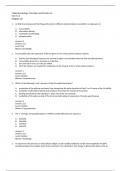
-
Chapter 22. The Posttranscriptional Regulation of Gene Expression in Eukaryotes
- Exam (elaborations) • 15 pages • 2023
- Available in package deal
-
- $8.49
- + learn more
Chapter 22. The Posttranscriptional Regulation of Gene Expression in Eukaryotes

How much did you already spend on Stuvia? Imagine there are plenty more of you out there paying for study notes, but this time YOU are the seller. Ka-ching! Discover all about earning on Stuvia


